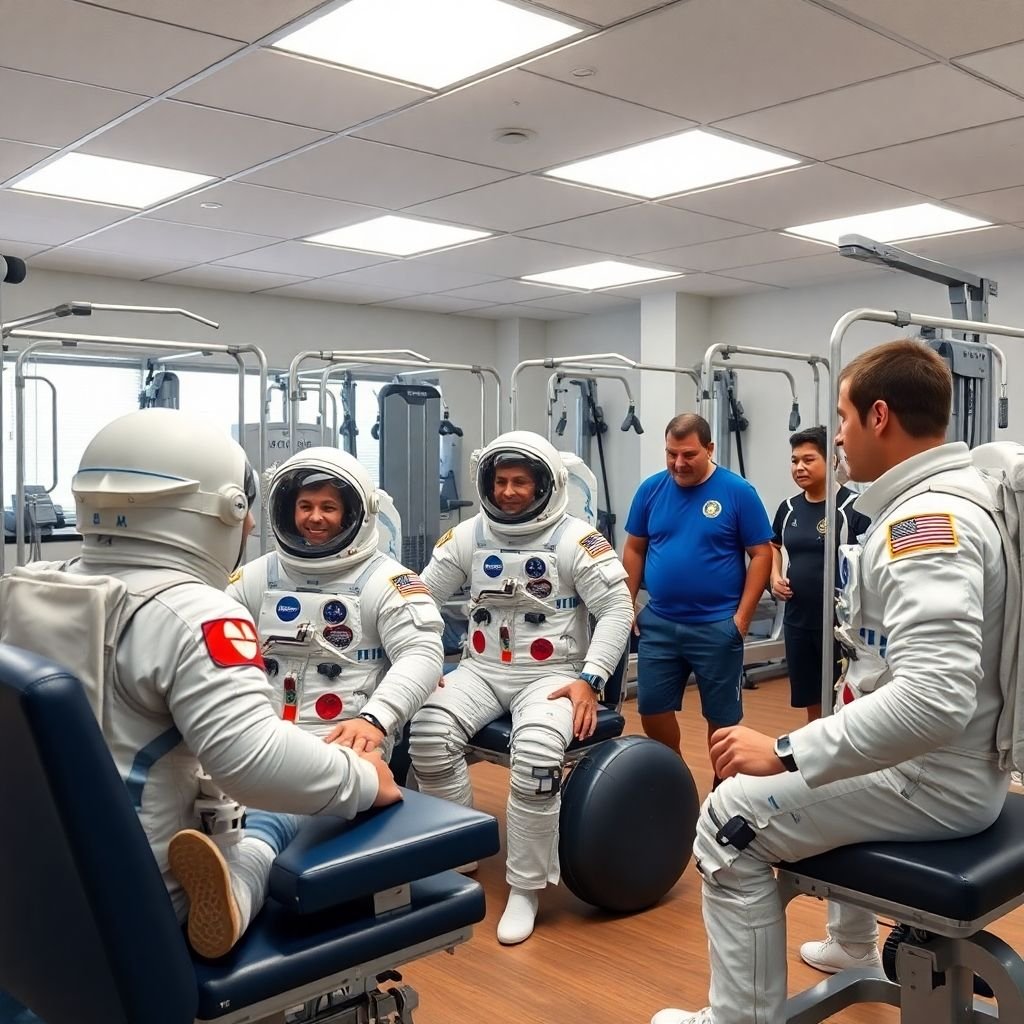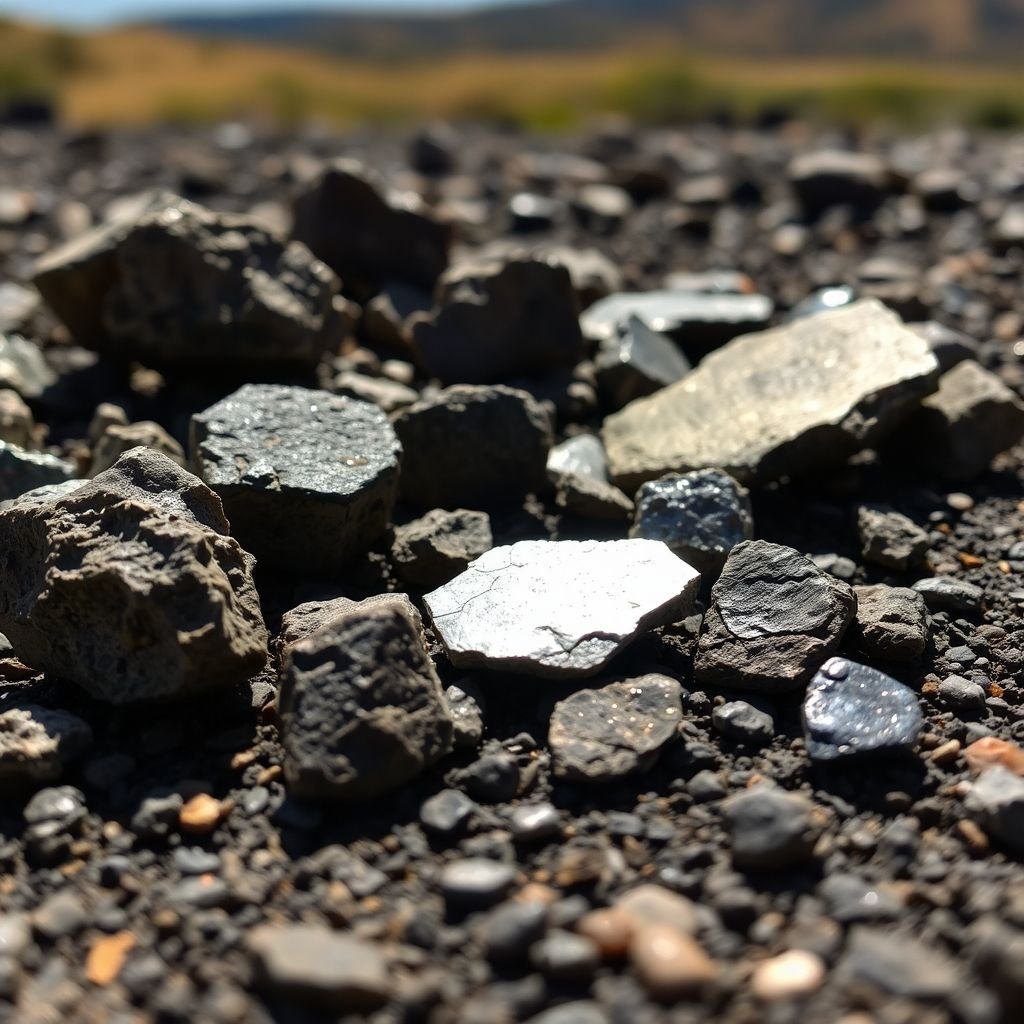When astronauts return to Earth after long missions in space, the journey back to normalcy is not just a walk in the park. The effects of microgravity can leave them with a range of physical and mental challenges. To address these, astronauts undergo a comprehensive rehabilitation programme that starts immediately after landing. This process is essential for helping them regain their strength, balance, and overall well-being, ensuring they can continue their vital work in space exploration.
Key Takeaways
- Astronauts face significant physical changes after long missions in microgravity, including muscle atrophy and balance issues.
- Rehabilitation begins as soon as they return, with immediate medical assessments and tailored physical therapy.
- The recovery process focuses on rebuilding strength and coordination, often feeling like learning to walk again.
- Technology plays a key role in rehabilitation, with wearable devices and AI helping to create personalised recovery plans.
- Mental health support is crucial, addressing feelings of anxiety and isolation that astronauts may experience after their missions.
Understanding The Impact Of Microgravity On Astronauts
Space travel sounds amazing, right? Floating around, seeing Earth from above… But it’s not all fun and games. Extended periods in microgravity can really mess with an astronaut’s body and mind. It’s not just about feeling a bit wobbly when they get back; the effects can be quite profound.
Physical Changes During Extended Missions
Living in space means your body doesn’t have to work as hard against gravity. This leads to some significant physical changes. Muscles start to waste away because they’re not being used as much. Astronauts can lose a surprising amount of muscle mass on long missions. Bone density also takes a hit; without gravity constantly loading the bones, they start to lose minerals. It’s like accelerated osteoporosis. The heart also doesn’t have to pump as hard, which can lead to cardiovascular deconditioning. It’s a bit like putting your body in slow motion, and it needs a serious jump start when they return. Astronauts need physical therapy to get back to normal.
Psychological Effects Of Long-Duration Space Travel
It’s not just the physical stuff that’s tough. Being cooped up in a spacecraft for months, far away from family and friends, can take a toll on mental health. Astronauts can experience feelings of isolation, anxiety, and even depression. The confined environment and lack of privacy can also contribute to stress. Plus, there’s the constant pressure of performing tasks flawlessly in a high-stakes environment. It’s a lot to handle, and psychological support is a key part of the rehabilitation process.
Health Risks Associated With Microgravity
Microgravity poses several health risks. Here are some of the main ones:
- Muscle atrophy: As mentioned, muscles weaken due to lack of use.
- Bone density loss: Bones become more brittle and prone to fractures.
- Cardiovascular problems: The heart can weaken, and blood pressure regulation can be affected.
- Vestibular issues: The inner ear, which controls balance, can be disrupted, leading to dizziness and disorientation.
- Radiation exposure: Astronauts are exposed to higher levels of radiation in space, which can increase the risk of cancer.
The body undergoes significant changes in space. It’s a harsh environment, and the human body isn’t really designed for it. That’s why rehabilitation programmes are so important – to help astronauts recover and adapt to life back on Earth.
These risks highlight the importance of in-flight exercise routines and post-flight rehabilitation programmes. NASA uses the Advanced Resistive Exercise Device to help astronauts stay in shape.
The Rehabilitation Process Begins Immediately

So, the moment an astronaut touches down, the recovery mission kicks off. It’s not like they get to chill with a cuppa right away; there’s a whole team ready to get them back on their feet, literally.
Initial Medical Assessments
First things first, the medical team does a thorough check-up. They’re looking at everything – blood pressure, heart rate, hydration levels, and even how their brain is functioning. It’s all about spotting any immediate problems caused by being in space. They need to make sure there aren’t any nasty surprises waiting to pop up. It’s like a Formula 1 pit stop, but for the human body.
Importance Of Early Intervention
Getting started quickly is super important. The sooner they start, the better the chances of a smooth recovery. Physical therapists are on hand almost immediately, guiding astronauts through gentle stretches and simple movements. It’s about reintroducing their bodies to gravity in a safe and controlled way. Think of it as easing back into reality after a long holiday, but with a lot more science involved.
Role Of Physical Therapists
Physical therapists are the unsung heroes of space travel recovery. They create personalised plans to help astronauts regain their strength, balance, and coordination. It’s not just about lifting weights; it’s about retraining the body to work properly back on Earth. They monitor progress closely, adjusting the exercises as needed. It’s a long process, but their expertise is key to getting astronauts back to feeling like themselves again.
The initial phase of rehabilitation is crucial for setting the stage for long-term recovery. It’s about addressing immediate medical needs and starting the process of readapting to Earth’s gravity. This early intervention can significantly impact the astronaut’s overall well-being and their ability to return to normal activities.
Rebuilding Strength And Coordination Post-Mission

After months in space, astronauts face a significant challenge: readjusting to Earth’s gravity. The microgravity environment leads to muscle atrophy and a decline in bone density, making the return to normal activities difficult. The rehabilitation process focuses intensely on rebuilding strength and coordination to ensure astronauts can safely and effectively resume their lives.
Focus On Muscle Recovery
The primary goal is to counteract muscle atrophy experienced during spaceflight. Astronauts undergo targeted resistance training to rebuild muscle mass and strength. This involves using specialised equipment that simulates weightlifting exercises on Earth. The intensity and duration of these exercises are gradually increased as the astronaut’s strength improves. It’s a slow process, and patience is key. The Advanced Resistive Exercise Device, or ARED, is a key piece of equipment for this.
Balance And Coordination Exercises
Space travel significantly impacts the vestibular system, which is responsible for balance and spatial orientation. Astronauts often experience dizziness and disorientation upon returning to Earth. Rehabilitation programmes include specific exercises designed to retrain the vestibular system and improve balance. These exercises may involve:
- Balance boards and wobble boards
- Gait training
- Visual tracking exercises
- Coordination drills
Regaining balance and coordination is not just about physical stability; it’s also about restoring confidence. Astronauts need to feel secure in their movements to perform daily tasks and participate fully in post-mission activities.
Gradual Return To Normal Activities
The return to normal activities is a carefully managed process. Astronauts gradually increase their activity levels, starting with light exercises and progressing to more demanding tasks. This approach helps prevent injuries and allows the body to adapt to the increased gravitational load. The physical therapists will design personalised rehabilitation programmes to gradually rebuild their strength and endurance, ensuring they can return to their daily lives safely. It’s like learning to walk again, but with the added challenge of overcoming the effects of prolonged spaceflight. It’s a marathon, not a sprint, and the focus is on long-term recovery and well-being.
Integrating Technology Into Rehabilitation
Space missions push the limits of human endurance, and the recovery process is just as innovative. Technology plays a huge role in getting astronauts back on their feet – literally. It’s not just about treadmills and weights anymore; we’re talking about high-tech solutions that are changing the game.
Wearable Biometric Devices
Imagine a souped-up fitness tracker. That’s essentially what these are. Wearable biometric devices bone density recovery monitor everything from heart rate and muscle mass to bone density and hydration levels. This constant stream of data allows medical teams to track an astronaut’s progress in real-time, both in space and back on Earth. It’s like having a personal health dashboard, providing insights that were previously impossible to obtain.
AI-Powered Recovery Plans
Forget generic workout routines. AI is now being used to create customised recovery plans tailored to each astronaut’s specific needs. The AI analyses the data from wearable devices and other sources to identify areas that need the most attention. It then generates a personalised rehabilitation programme, adjusting exercises and intensity as the astronaut progresses. It’s like having a personal trainer who knows your body inside and out.
Telehealth Consultations
Being isolated in space doesn’t mean being cut off from medical expertise. Telehealth consultations allow therapists to check in with astronauts remotely, monitor their movements in real-time, and adjust exercises on the fly. This is especially useful during long missions or when astronauts are in remote locations. It ensures that they receive the support they need, no matter where they are.
The integration of technology into astronaut rehabilitation is not just about improving physical recovery; it’s about enhancing overall well-being. By providing personalised, data-driven care, we can help astronauts return to Earth feeling stronger, healthier, and more prepared for future missions.
Mental Health Support During Recovery
Coming back to Earth isn’t just a physical challenge; it’s a big mental adjustment too. After months or even years in space, astronauts can find it hard to readjust to life back home. It’s not just about gravity; it’s about everything – the noise, the people, the constant stimulation. Mental health support is a vital part of the recovery process.
Addressing Anxiety And Isolation
Space missions can be isolating, and that feeling doesn’t always disappear the moment they land. Astronauts might struggle with anxiety about re-entering society, reconnecting with family, or even just dealing with the sheer volume of sensory input after being in a controlled environment for so long. It’s important to acknowledge these feelings and provide a safe space for them to talk about their experiences. Support groups, therapy sessions, and even just having someone to listen can make a huge difference. It’s about reminding them that they’re not alone in this.
Mindfulness Techniques
Mindfulness and meditation can be really helpful tools for astronauts as they transition back to Earth. These techniques can help them manage stress, reduce anxiety, and improve their overall sense of well-being. Simple exercises like deep breathing, focusing on the present moment, and practising gratitude can make a big difference. It’s about giving them the tools to manage stress and stay grounded, even when things feel overwhelming.
Building Resilience
Resilience is key for astronauts, both in space and back on Earth. The ability to bounce back from setbacks, adapt to new situations, and maintain a positive outlook is crucial for their long-term well-being. Building resilience involves a combination of factors, including strong social support, effective coping mechanisms, and a sense of purpose. It’s about helping them develop the mental toughness they need to face whatever challenges come their way.
It’s not about pretending everything is perfect; it’s about acknowledging the difficulties, learning from them, and moving forward with strength and determination. The mental journey is just as important as the physical one, and we need to support our astronauts every step of the way.
Preparing For Future Missions To Mars

Space exploration is constantly pushing boundaries, and Mars is the next big target. But getting there and back presents unique challenges, especially when it comes to astronaut health. We need to think long-term about how we prepare astronauts for these extended missions and how we help them recover afterwards. It’s not just about surviving the journey; it’s about thriving.
Long-Term Rehabilitation Strategies
For Mars missions, rehabilitation can’t be an afterthought; it needs to be integrated into the entire mission plan. This means starting pre-flight conditioning well in advance, continuing support during the mission itself, and having robust post-flight recovery protocols. The goal is to minimise the long-term effects of microgravity and radiation exposure.
Here’s a breakdown of key areas:
- Personalised Exercise Regimens: Tailored to each astronaut’s physiology and mission role.
- Nutritional Support: Optimised diets to combat bone loss and muscle atrophy.
- Mental Health Strategies: Addressing the psychological challenges of long-duration space travel.
We need to shift from reactive to proactive rehabilitation. This involves continuous monitoring of astronaut health, using data to adjust exercise and nutrition plans in real-time, and providing ongoing psychological support.
Innovations In Space Therapy
Technology is playing a huge role in transforming space therapy. We’re seeing exciting developments that could make a real difference to astronaut health on future Mars missions. For example, aerospace medicine is constantly evolving.
Some key innovations include:
- Virtual Reality (VR) Rehabilitation: Simulating Earth-like environments to help astronauts maintain balance and coordination.
- Robotic Exoskeletons: Providing resistance and support to combat muscle loss.
- Regenerative Medicine: Exploring therapies to repair tissue damage caused by microgravity and radiation.
The Role Of Robotics In Recovery
Robotics can assist astronauts during missions and in post-flight recovery. In space, robots can help with exercise, providing resistance and monitoring progress. Back on Earth, they can assist with physical therapy, guiding movements and providing feedback. This is especially important given the importance of early intervention in the recovery process.
Consider these applications:
- Robotic Exercise Partners: Providing personalised workouts and monitoring performance.
- Assistive Devices: Helping astronauts regain mobility and coordination.
- Remote Monitoring: Tracking progress and providing feedback from afar.
The Importance Of Ongoing Physical Therapy

Astronauts face unique physical challenges during space missions, and the need for physical therapy doesn’t end when they return to Earth. It’s an ongoing process, vital for maintaining their health and preparing them for future missions. It’s not just about recovering; it’s about sustaining a level of fitness that allows them to continue contributing to space exploration. The long-term effects of microgravity can linger, so consistent care is essential.
Maintaining Health For Future Missions
Ongoing physical therapy is crucial for astronauts who may undertake further spaceflights. It helps to counteract the long-term effects of previous missions, ensuring they are in optimal condition for future endeavours. This includes maintaining bone density, muscle strength, and cardiovascular health. Regular assessments and tailored exercises can prevent recurring issues and enhance their overall well-being. Think of it as preventative maintenance for the human body in extreme environments. It’s about building resilience and ensuring they can withstand the rigours of space travel again.
Customised Rehabilitation Programmes
Each astronaut’s experience in space is unique, and so too should be their rehabilitation programme. Personalised plans are essential, taking into account their specific physical challenges, mission duration, and individual health history. These programmes should be regularly reviewed and adjusted based on their progress and any new issues that arise. This tailored approach ensures that astronauts receive the most effective care, addressing their specific needs and maximising their recovery potential. It’s not a one-size-fits-all solution; it’s about understanding the individual and crafting a plan that works for them.
The Future Of Astronaut Recovery
As we look towards longer and more ambitious space missions, such as those to Mars, the future of astronaut recovery is evolving. This includes the integration of advanced technologies like virtual reality, robotic-assisted therapy, and regenerative medicine. These innovations aim to enhance rehabilitation efforts, making them more effective and efficient. Furthermore, research is ongoing to develop new strategies for mitigating the long-term effects of space travel, ensuring that astronauts can return to Earth healthy and ready for their next adventure. The future of space therapy is bright, with exciting possibilities on the horizon.
The focus is shifting towards proactive and preventative measures. Instead of solely addressing issues after a mission, the emphasis is on maintaining optimal health throughout an astronaut’s career. This includes continuous monitoring, personalised exercise programmes, and mental health support, ensuring they are always ready for the challenges of space exploration.
The Path to Recovery
In the end, the journey back to Earth for astronauts is just the beginning of a long road to recovery. After months in space, their bodies need time to adjust and heal. The rehabilitation programmes are designed to help them regain strength, balance, and overall fitness. It’s not just about physical health; mental well-being plays a big part too. As we look ahead to future missions, especially those to Mars, the importance of these recovery protocols will only grow. With new technologies and methods on the horizon, we can ensure that astronauts not only survive their missions but thrive when they return home. The adventure doesn’t stop in space; it continues right here on Earth.
Frequently Asked Questions
What changes do astronauts experience after long missions in space?
Astronauts can face several physical changes after being in space for a long time. They may lose muscle strength and bone density, feel dizzy, and have trouble balancing due to the effects of microgravity.
How does the rehabilitation process start after landing?
Once astronauts return to Earth, rehabilitation begins right away. Medical teams check their vital signs, and physical therapists start with gentle exercises to help them adjust to gravity again.
What kind of exercises do astronauts do during rehabilitation?
During rehabilitation, astronauts do a mix of exercises to rebuild strength and balance. This can include simple movements like standing or walking, as well as more intense workouts to regain muscle and fitness.
How is technology used in astronaut rehabilitation?
Technology plays a big role in astronaut rehabilitation. Wearable devices track their health, while AI helps create custom recovery plans. Telehealth allows therapists to monitor their progress even from afar.
What mental health support is available for astronauts after missions?
Mental health support is very important for astronauts returning from space. Therapists help them deal with feelings of anxiety or isolation, often using techniques like mindfulness to aid their adjustment.
What are the future plans for astronaut rehabilitation for missions to Mars?
For future missions to Mars, rehabilitation will be even more crucial. New strategies like virtual reality training, robotic help, and advanced medical treatments are being explored to ensure astronauts stay healthy during long space journeys.








